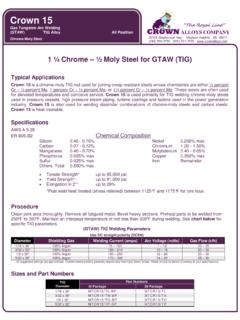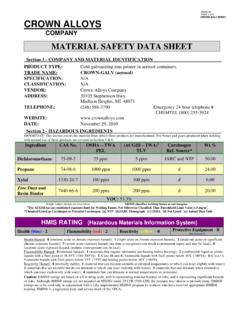Transcription of STEEL PREHEATING CHART - Crown Alloys
1 STEEL PREHEATING CHART . Pre- heating will eliminate crack formation, reduce distortion and prevent shrinkage stresses Metal Metal %C Recommended Group Designation Preheat ( F)0. Plain Plain carbon STEEL Up to 200. Carbon Plain carbon STEEL . 200-300. STEEL Plain carbon STEEL . 300-500. Plain carbon STEEL . 500-800. Carbon Moly Carbon moly STEEL . 300-500. Steels Carbon moly STEEL . 400-600. Carbon moly STEEL . 500-800. Manganese Silicon structural STEEL .35 300-500. Steels Medium Manganese STEEL . 300-500. SAE T 1330 STEEL .30 400-600. SAE T 1340 STEEL .40 500-800. SAE T 1350 STEEL .50 600-900. 12% Manganese STEEL Usually not required High Tensile Manganese moly STEEL .20 300-500. Steels Manten STEEL .30 max 400-600. Armco high Tensile STEEL .
2 12 max Up to 200. Mayari R STEEL .20 max Up to 300. Nax high tensile . Up to 300. Cromansil STEEL .14 max 300-400. Corten STEEL .12 max 200-400. Yoloy STEEL . 200-600. Nickel SAE 2015 STEEL . 200-300. STEEL SAE 2115 STEEL . 200-300. 2 1/2% nickel STEEL . 200-400. SAE 2315, 2320 STEEL . 200-500. SAE 2330, 2340 STEEL . 400-600. Medium SAE 3115, 3125 STEEL . 300-400. Nickel Chromium SAE 3130, 3140 STEEL . 500-700. STEEL SAE 3150 STEEL .50 600-900. SAE 3215, 3230 STEEL . 400-600. SAE 3240, 3250 STEEL . 800-1000. SAE 3315 STEEL .15 500-700. SAE 3325, 3435 & 3450 .25-50 900-1100. Moly Chromium SAE 4140 STEEL .40 600-800. & Chromium Nickel SAE 4340 STEEL .40 700-900. Steels SAE 4615 STEEL .15 400-600. SAE 4630 STEEL .30 500-700. SAE 4640, 4820 STEEL .
3 40-20 600-800. Low Chrome Moly 2% Cr. - 1/2% Up to .15 400-600. Steels 2% Cr. - 1/2% Mo. STEEL . 500-800. 2% Cr. - 1% Mo. STEEL Up to .15 500-700. 2% Cr. - 1% Mo. STEEL .15 max 600-800. Medium 5% Cr. - 1/2% Mo. STEEL Up to .15 500-800. Chrome Moly 5% Cr. - 1/2% Mo. STEEL . 600-900. STEEL 8% Cr. - 1% Mo. STEEL .15 max 600-900. High Chrome 12-14% Cr. type 410 .10 300-500. Steels 16-18% Cr. type 430 .10 300-500. 23-30% Cr. type 446 .10 300-500. The need for PREHEATING increases as the following factors are changed. 1. The larger the mass being welded. 5. The greater the speed of welding. 2. The lower the temperature of the parts. 6. The higher the carbon content of the STEEL . 3. The lower the atmospheric temperature. 7. The greater the alloy content.
4 4. The smaller the weld rod in diameter. 8. The more complicated the shape.









